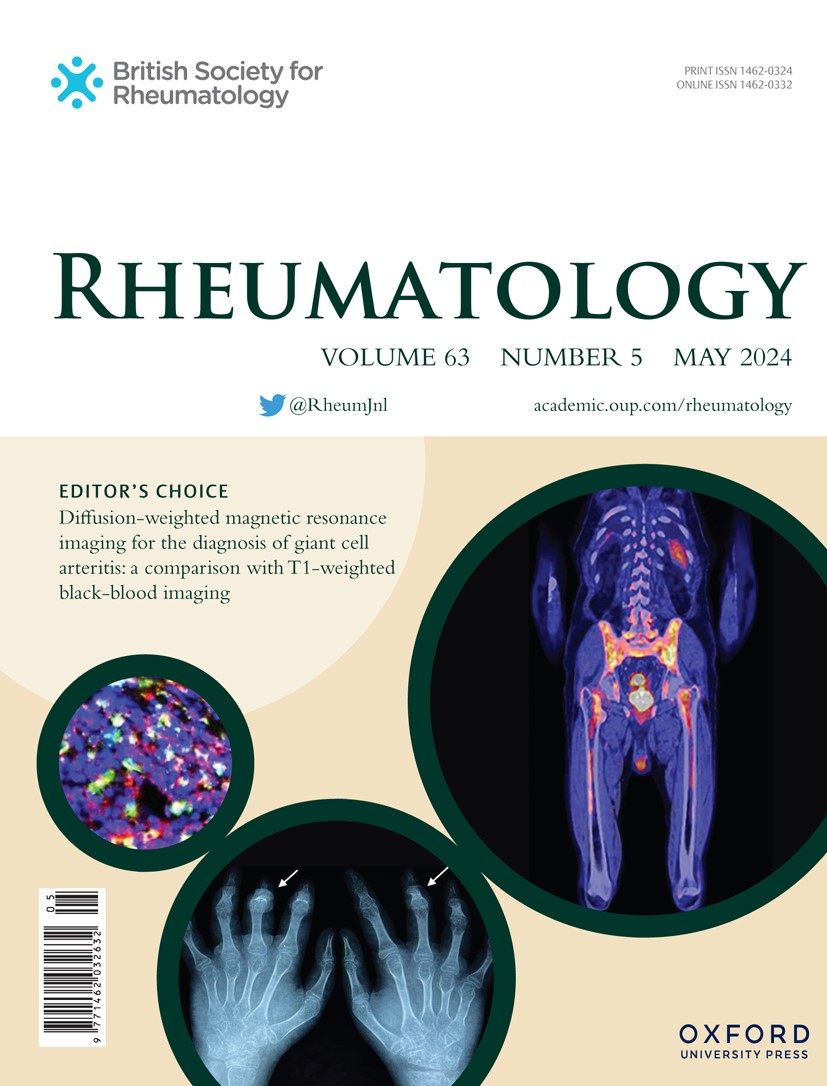Anti-peptide antibodies, anti-SNRK and anti-HUWE1 antibodies, as potential predictors of good response to tofacitinib therapy in rheumatoid arthritis patients
IF 4.7
2区 医学
Q1 RHEUMATOLOGY
引用次数: 0
Abstract
Objectives To maximize the cost-effectiveness of tofacitinib, one of Janus kinase inhibitors, there is an unmet need to identify predictors of therapeutic response. Utilizing phage immunoprecipitation sequencing (PhIP-Seq), we aim to identify peptide biomarkers for predicting good response to tofacitinib in rheumatoid arthritis (RA) patients. Methods We enrolled 106 patients who had received 24-week tofacitinib therapy, including twelve patients undergoing PhIP-Seq analysis in the discovery stage and ninety-four patients validated with enzyme-linked immunosorbent assay (ELISA) in the replication stage. Disease activity was assessed using the 28-joint disease activity score-erythrocyte sedimentation rate, and therapeutic response was evaluated using EULAR response criteria. Plasma levels of caspase-1 and IL-18 were determined using ELISA. Results PhIP-Seq analysis identified antibodies to sucrose non-fermenting-related kinase (SNRK) and HUWE1 (ubiquitin E3 ligase) as peptide biomarkers for discriminating good responders from the non-good responders. Using ELISA for validation on another cohort, an optimal cut-off value of anti-SNRK antibody for predicting good response was 0.381, with AUC 0.823, specificity 80.6%, and sensitivity 78.1% (p = 3.01E-07), and anti-HUWE1 antibody at 0.362, with AUC 0.740, specificity 74.2%, and sensitivity 62.5% (p < 0.001). Plasma levels of anti-SNRK and anti-HUWE1 antibodies were positively correlated with levels of caspase-1 and IL-18 (both p < 0.05). Multivariate logistic regression analysis revealed anti-SNRK antibody as a significant predictor of good therapeutic response. After tofacitinib therapy, anti-SNRK antibody levels significantly declined in good responders, but not in non-good responders. Conclusion We identify two peptide antibodies, anti-SNRK and anti-HUWE1 antibodies, as pretreatment predictors of good therapeutic response to tofacitinib in RA patients.抗肽抗体、抗SNRK抗体和抗HUWE1抗体是类风湿性关节炎患者对法替尼治疗良好反应的潜在预测因子
目的 为了最大限度地提高 Janus 激酶抑制剂之一托法替尼的成本效益,目前尚需确定治疗反应的预测指标。我们利用噬菌体免疫沉淀测序(PhIP-Seq)技术,旨在确定预测类风湿性关节炎(RA)患者对法替尼良好反应的肽生物标志物。方法 我们招募了106名接受过24周托法替尼治疗的患者,其中12名患者在发现阶段接受了PhIP-Seq分析,94名患者在复制阶段接受了酶联免疫吸附试验(ELISA)验证。疾病活动性采用28关节疾病活动性评分-红细胞沉降率进行评估,治疗反应采用EULAR反应标准进行评估。血浆中 caspase-1 和 IL-18 的水平采用 ELISA 法测定。结果 PhIP-Seq分析发现,蔗糖不发酵相关激酶(SNRK)和泛素E3连接酶(HUWE1)抗体是区分良好反应者和非良好反应者的肽生物标志物。使用酶联免疫吸附法对另一个队列进行验证后发现,预测良好反应的抗SNRK抗体最佳临界值为0.381,AUC为0.823,特异性为80.6%,灵敏度为78.1%(p = 3.01E-07);抗HUWE1抗体最佳临界值为0.362,AUC为0.740,特异性为74.2%,灵敏度为62.5%(p < 0.001)。血浆中抗SNRK和抗HUWE1抗体水平与caspase-1和IL-18水平呈正相关(p均为0.05)。多变量逻辑回归分析显示,抗SNRK抗体是良好治疗反应的重要预测因子。接受托法替尼治疗后,良好应答者的抗SNRK抗体水平显著下降,而非良好应答者的抗SNRK抗体水平则没有显著下降。结论 我们发现抗SNRK抗体和抗HUWE1抗体这两种肽抗体是预测RA患者对法替尼良好治疗反应的预处理指标。
本文章由计算机程序翻译,如有差异,请以英文原文为准。
求助全文
约1分钟内获得全文
求助全文
来源期刊

Rheumatology
医学-风湿病学
CiteScore
9.40
自引率
7.30%
发文量
1091
审稿时长
2 months
期刊介绍:
Rheumatology strives to support research and discovery by publishing the highest quality original scientific papers with a focus on basic, clinical and translational research. The journal’s subject areas cover a wide range of paediatric and adult rheumatological conditions from an international perspective. It is an official journal of the British Society for Rheumatology, published by Oxford University Press.
Rheumatology publishes original articles, reviews, editorials, guidelines, concise reports, meta-analyses, original case reports, clinical vignettes, letters and matters arising from published material. The journal takes pride in serving the global rheumatology community, with a focus on high societal impact in the form of podcasts, videos and extended social media presence, and utilizing metrics such as Altmetric. Keep up to date by following the journal on Twitter @RheumJnl.
 求助内容:
求助内容: 应助结果提醒方式:
应助结果提醒方式:


